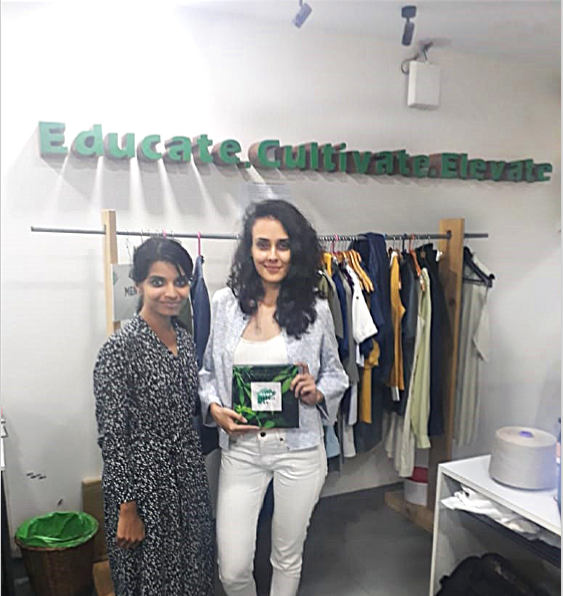
Up your sustainable style quotient with BOHECO
Share
We live in a world of Face App challenge and here young people find it entertaining to see their selves instantly transform into a grizzled, creased and flabby old face. But how would one feel to time travel and see an actual older and worn version of earth, not with wrinkles and grey stubbles here and there but with never-ending swathes of famine fields and drought zones? Will it be equally fascinating?
We constantly buy new clothes, dispose of our old ones and consequently, every single one of us has to witness the catastrophe of environmental destruction, on the internet or by just looking outside our windows — straight into the blackened marine waters and massive heaps of landfills.
Yes, textile dumps so far are getting larger than we fear.
We forget that before reaching the closet our clothes have to be dyed, bleached and stained by the exploitation of helpless labourers. Our consumption habits are massacring aquatic life, uprooting millions of trees and threatening the future of our home planet.
“People don’t seem to understand how much goes into these clothes. They think about it the same way they do with a pizza box.” — Anika Kozlowski, (assistant professor of Fashion Design, Ethics & Sustainability at Ryerson University).
But what if I told that you could buy a T-shirt that’s biodegradable, uses less water, is cheaper, lasts longer, unlike your average cotton T-shirt? You’d probably tell me that’s impossible, right? But you’re wrong.
It’s because Hemp clothing exists, and it just might change the future of our planet for better.
Any mention of hemp in India wouldn’t be complete without talking about Bombay Hemp Company (BOHECO). BOHECO is a landmark startup based in Mumbai that pioneers the hemp revolution in India.
I got to visit BOHECO and become so obsessed with hemp that I practically got converted into a ‘hempster.’ The office decor bore an outlook and feel which induced me to worship nature. BOHECO taught me to imagine an outfit so organic, out-of-the-box and the one that’s not stitched with even an iota of cotton or linen, which are ageing our planet at a rapidly alarming rate.
For starters, Hemp is an eco-friendly miracle fabric produced out of the stem of a plant named Cannabis Sativa.
Wait…. cannabis? Isn’t that marijuana?
Well, even though hemp and marijuana belong to the same genus, hemp crop contains only 0.3 per cent of the psychoactive substance (THC). Sorry peeps, we can’t get high on hemp.
But wearing something hemp-woven is getting addictive day by day and the designers seemed to have taken note of this upward trend.
Designer luxury clothing made of a holistic blend of hemp and silk is ruling the runway. Donatella Versace, Ralph Lauren, Calvin Klein, Isabella Toledo, Behnaz Sarafour and numerous others have experimented with hemp.
Hemp fabrics are not restricted to limited edition fashion shows but are also a popular choice for day to day wear. Hemp T-Shirts are deliciously soft on the skin and get softer with every wash. Hemp is so soft that there would be a lot of people around who’d just want to feel that material you’re haughtily blasting off over yourself. The cut and design of hemp cloth are such that it makes all body types look fabulous.
Raw hemp fabrics are always ‘on’ for miscellany as hemp-woven flannels, lingerie, sportswear, routine shirts-pants and even furnishing and upholstery swiftly express themselves in a diverse colour palette.
It’s also naturally resistant to bacteria and provides instant UV protection. Hemp also retains colour longer than other fabrics.
But style and comfort aren’t the biggest upsides of hemp. The greatest advantage of hemp fabric is that its kind and gentle to its farmers, weavers, and environment.
Hemp grows quickly, naturally resists plant diseases, requires little weeding and thrives in most climates. Amazingly, hemp enriches the soil it grows in. It actually releases 50 to 60% of nutrients back to the soil as opposed to cotton which sucks out all the nutrients from the soil. It also requires very little water, especially when compared to cotton, It also increases the farmer’s profit margin by saving the cost of genetically modified seeds.
I’ve positively realized that hemp manufacturing respects and cherishes those cloth spinners who are inevitably tied to our beings as we disguise our skin with a piece of their hidden labour.
Hemp assures that indigenous weavers don’t have to lose their natural way of life to earn a living. Especially in India, Hemp production nurtures the likes of those women living in the villages of the Himalayan region who have been spinning the tough fibre of hemp for decades.
After learning so much about hemp, the moral high-ground you’ll stand on knowing you’ll be wearing a sustainable fabric must feel refreshing.
Why We Didn’t Know About hemp and Start Using it Long Ago?
Well, the usage of hemp fibre as materials for clothing is not something new. The Vedas, refer to it as one of five sacred plants of India. Buddhist and Jain monks wore hemp as a cheap and easily available option. In Ramayana, Ram and Lakshman had changed into valkal or hemp before leaving for their vanavaas (forced exile). The Mahabharata tells the story of the Sakas (Central Asian Iranians) bringing gifts of hemp thread to India.
Artists such as Van Gogh and Rembrandt painted on 100% hemp canvas.
Besides, the American Declaration of Independence was written on hemp paper.
Later our society tabooed hemp or cannabis Sativa because of its genetic relations with marijuana and laws banning hemp came to be implemented. But having done a reality check, it’s evident that hemp affects so many industries — it’s one of the most useful and sustainable plants — and I think we shouldn’t be afraid of that.
For a fact, hemp might replace all that’s causing the trouble of adverse climate change. Hemp oil can be used to create bio-fuels which produce less of the greenhouse gases and are renewable (unlike petrol and diesel). A variety of alternatives to plastic can be made from hemp. Moving towards hemp for paper can potentially save the world’s forests.
According to Mansi Shah, Business Head of Hemp Fabric Lab — the digital offshoot of BOHECO, many companies and designers around the world are opening up to the wonders of hemp fabric, its long-term benefits on the planet and are passionate to come out as environmentally aware brands.
Hemp Fabric Lab isn’t the typical clothe shopping website but a universal destination showcasing a vibrant variety of hemp and hemp blend fabrics. In the effect, having an eco-friendly laundry is not just easy but an instant click away.

I tested one of their fabric swatch diaries at their plush office space and felt the touch of hemp clothes that popped out in numerous shades of colours. But most importantly, I remember that it’s so soft, you feel like hugging it
I also surfed their website hempfabriclab.com and felt embraced by a pure variety of fabrics to used for apparels, accessories and bed sheets that simply won’t harm the environment and it just feels right for our nature-loving souls.
No minimum order is required and so we have the freedom to cut out our favourite fabrics as per our bohemian whims and desires.

BOHECO-led Hemp revolution gradually made its presence felt in the country’s art and culture space. For instance, Mumbai Art Room hosted a large and attractive art installation by artist Waylon James D’Souza, made purely out of the Hemp fabric. The fabric patches are fully sourced by the company.
Even today, BOHECO continues to play a major role in blending hemp in fashion culture and maximum lifestyle of Mumbai through its interactive workshops, monthly sales and giveaways.
I feel that such enthusiasm in the revival of hemp usage is critical because it’s pollinating the next breed of mankind into a symbiotic ecosystem that flourishes in nature’s belly.
To sum it up, we’re sailing for a future that has to be buoyed up by a deliberate affinity of sustainable living and young hemp start-ups like Bombay Hemp Company drive us to pulse those lifestyles that are in sync with the great laws which discreetly orchestrate our planet’s wondrous symphony.


